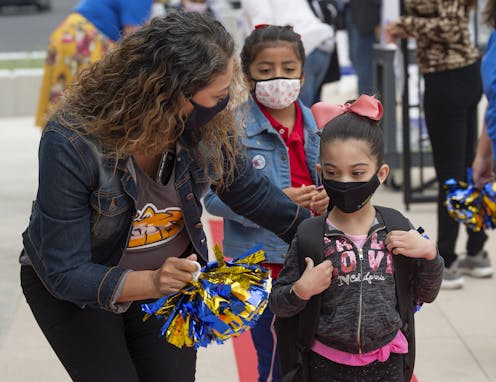America goes back to school – 5 essential reads on parenting in the pandemic
- Written by Jamaal Abdul-Alim, Education Editor, The Conversation

Beyond safety and survival, a paramount question throughout the pandemic has been: When will things get “back to normal”? But as the nation gradually gets vaccinated[1] against COVID-19 and various facets of society begin to reopen, it becomes evident that a return to normalcy poses a whole new set of questions, challenges and concerns.
Perhaps nowhere is this more apparent than when it comes to the education and parenting of America’s school-age children, whose childhoods have been uprooted in unparalleled ways since the pandemic struck in early 2020. Here we highlight five articles that help parents and educators better understand and do what it takes to get kids back to their classrooms, friends and regular routines.
1. How can America’s schools safely reopen?
That’s a question that Brandon Guthrie[2], an epidemiologist at the University of Washington, takes up in a piece about the conditions that must be met[3] in order for in-person instruction to resume.
On the question of how many teachers need to be vaccinated for schools to safely reopen, Guthrie writes that there is “no magic number.”
“In fact, the Centers for Disease Control and Prevention advises that in-person learning can start safely as long as other mitigation protocols like mask-wearing and adequate ventilation are in place,” Guthrie writes. “Vaccines offer an added level of protection.”
2. How soon can kids get the COVID-19 vaccine?
James B. Wood[4], an assistant professor of clinical pediatrics at Indiana University School of Medicine, addresses five questions parents are asking[5] about when their children can get vaccinated.
“Before kids under 16 can be vaccinated, clinical trials need to be completed in thousands of young volunteers to assess the vaccines’ safety and efficacy, and the results must be fully reviewed and the vaccine authorized by the FDA,” Wood writes.
3. What about physical school conditions?
COVID-19 isn’t the only threat children face as in-person instruction becomes more common. Michael Addonizio[6], an education policy scholar at Wayne State University, shines light on the deteriorating conditions at many of America’s schools[7] and the threat those conditions pose to students.
“Many kids are attending public schools this spring with the use of COVID-19 safety protocols, including more desk spacing, more frequent cleaning and mandates to wear masks,” Addonizio writes. “But far too many of the school buildings themselves remain dilapidated, toxic and in desperate need of structural improvements.”
4. How can children’s stress be reduced?
With all the concerns about what it takes to safely reopen the physical buildings that house America’s schools, it can be easy to forget that child well-being is a critical part of the equation. With that in mind, Amanda Sheffield Morris[8], a professor of human development and family science, and Jennifer Hays-Grudo, a professor of psychiatry and behavioral sciences, offer 10 research-proven strategies[9] on how parents can help their children reduce the stress brought about by the pandemic.
Among other things, they prescribe “protective and nurturing experiences” – such as keeping homes free of chaos and clutter – that they describe as “powerful antidotes to stress and adversity and prepare children to cope with hard times for years to come.”
“Decades of research have taught us that adversity during childhood has damaging effects on health and development,” the two professors write. “Fortunately, developmental scientists have identified ways to help children survive and thrive during times of adversity.”
5. How can kids overcome fear of going outside?
Some parents may find it difficult just to get their children to even want to go back out into the world.
Dominique A. Phillips[10], a Ph.D. student in clinical psychology, and Jill Ehrenreich-May[11], a professor of psychology, offer insights on how to help kids break out of their pandemic bubble[12].
“While it may feel easier in the moment to accommodate your child’s desire to avoid social situations that feel more awkward or overwhelming than before, it is important not to reinforce such behavior,” the duo from the University of Miami write. “Prolonged avoidance can lead to even more anxiety and less confidence in socializing.”
Editor’s note: This story is a roundup of articles from The Conversation’s archives.
[You need to understand the coronavirus pandemic, and we can help. Read The Conversation’s newsletter[13].]
References
- ^ gradually gets vaccinated (covid.cdc.gov)
- ^ Brandon Guthrie (theconversation.com)
- ^ the conditions that must be met (theconversation.com)
- ^ James B. Wood (theconversation.com)
- ^ addresses five questions parents are asking (theconversation.com)
- ^ Michael Addonizio (theconversation.com)
- ^ deteriorating conditions at many of America’s schools (theconversation.com)
- ^ Amanda Sheffield Morris (theconversation.com)
- ^ 10 research-proven strategies (theconversation.com)
- ^ Dominique A. Phillips (theconversation.com)
- ^ Jill Ehrenreich-May (theconversation.com)
- ^ break out of their pandemic bubble (theconversation.com)
- ^ Read The Conversation’s newsletter (theconversation.com)
Authors: Jamaal Abdul-Alim, Education Editor, The Conversation

